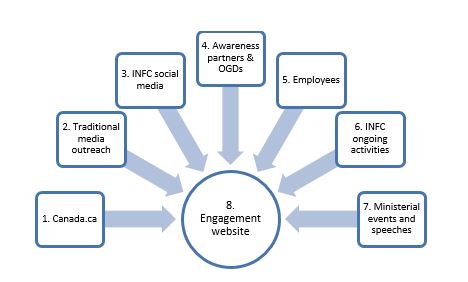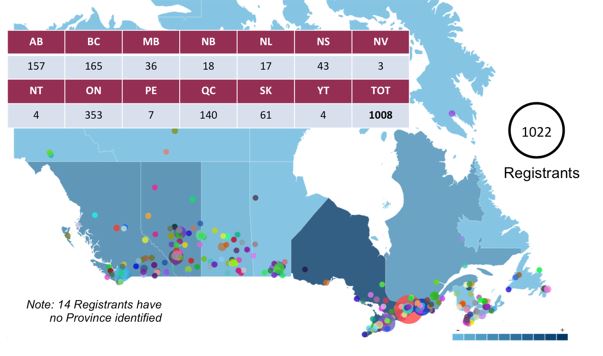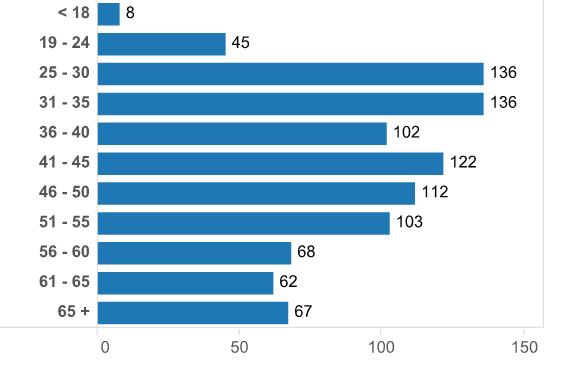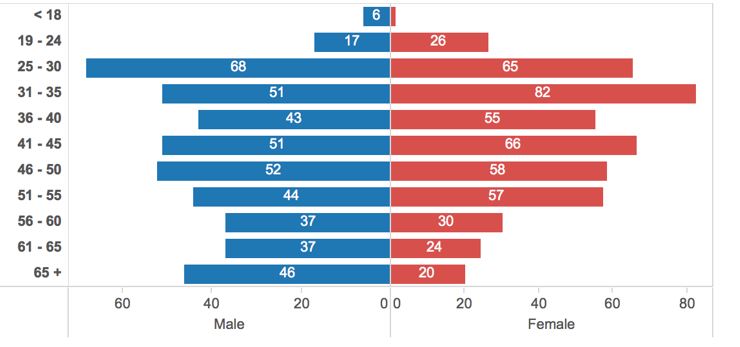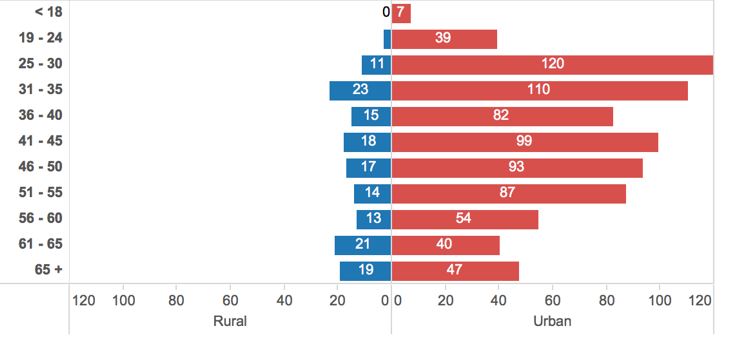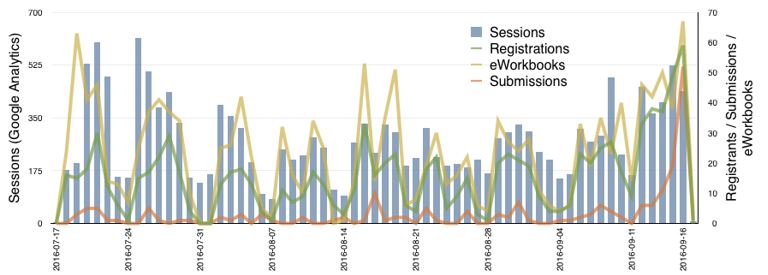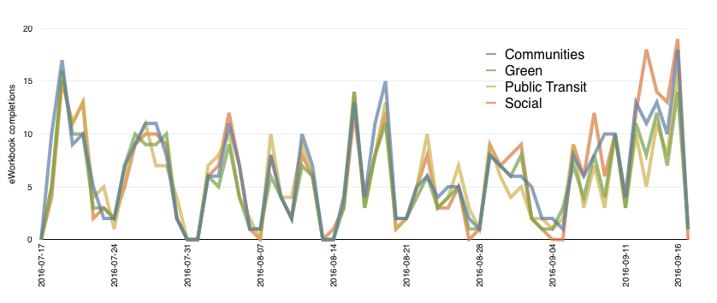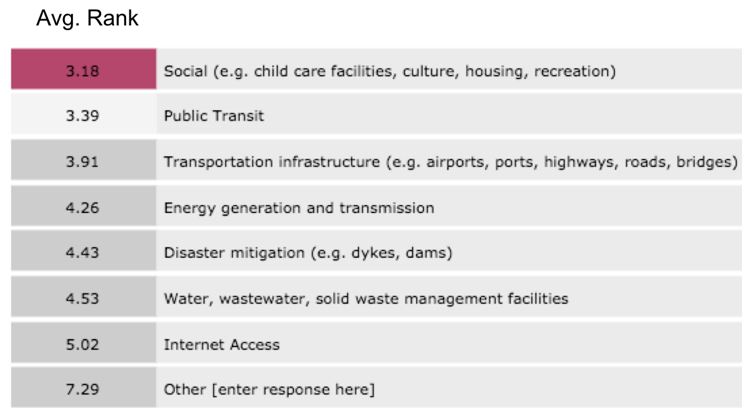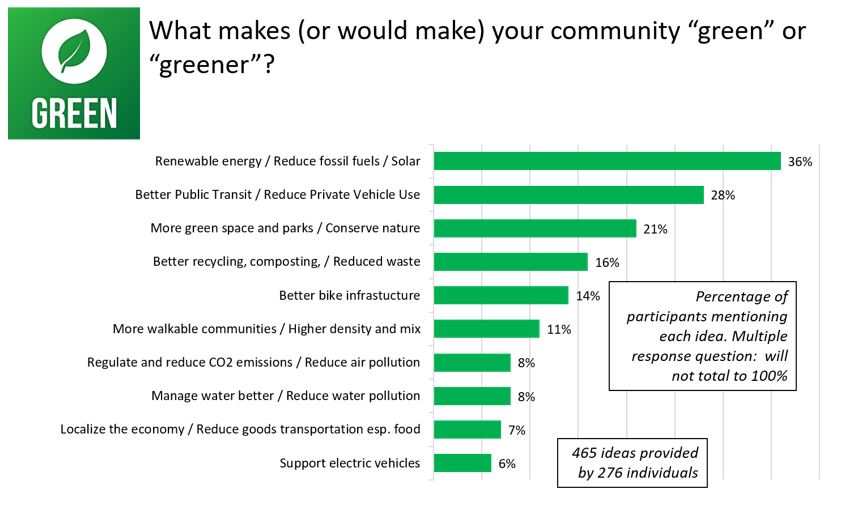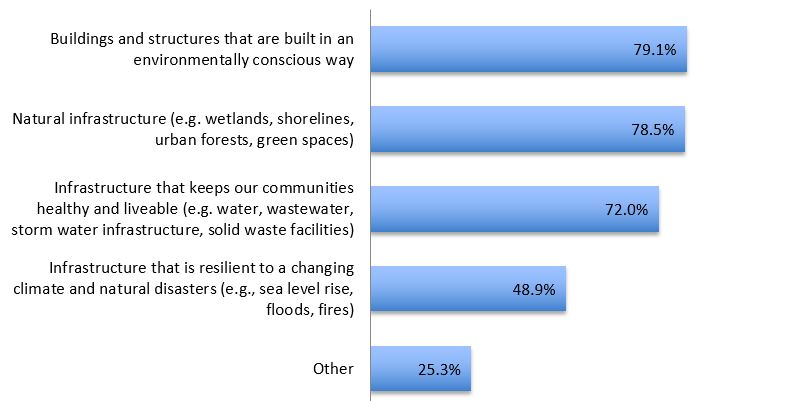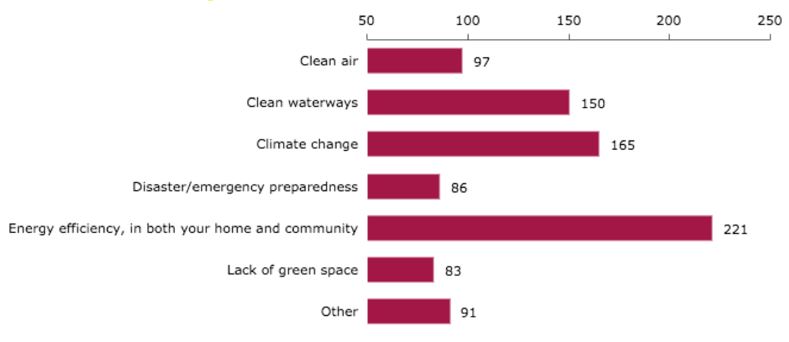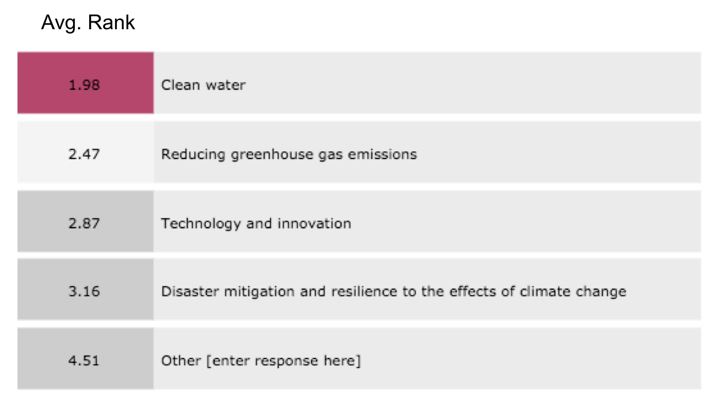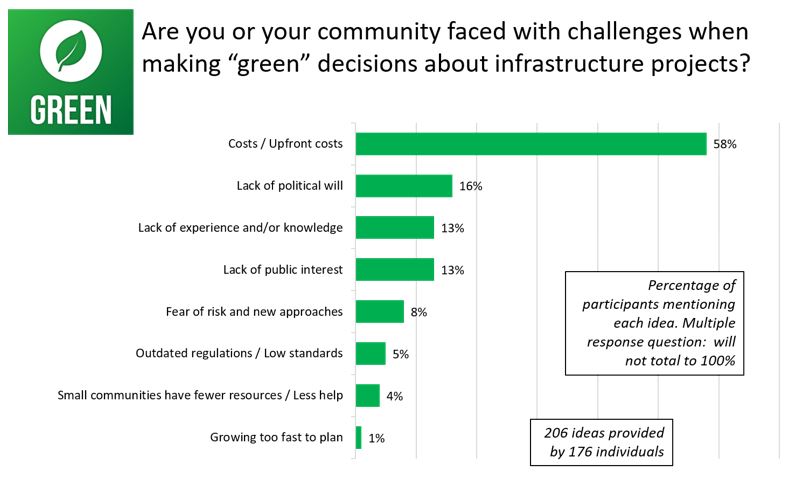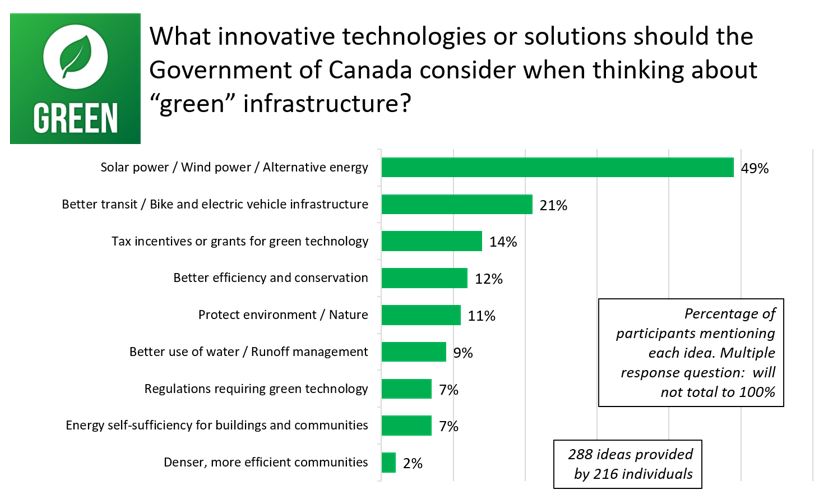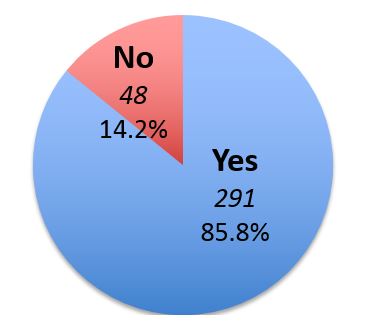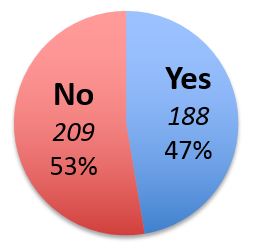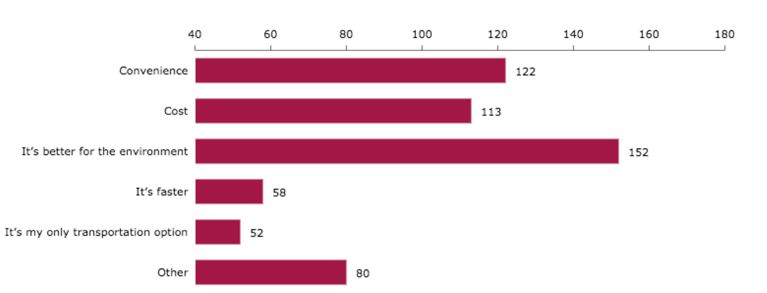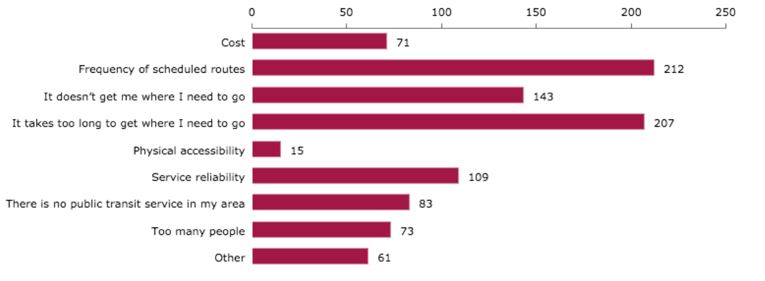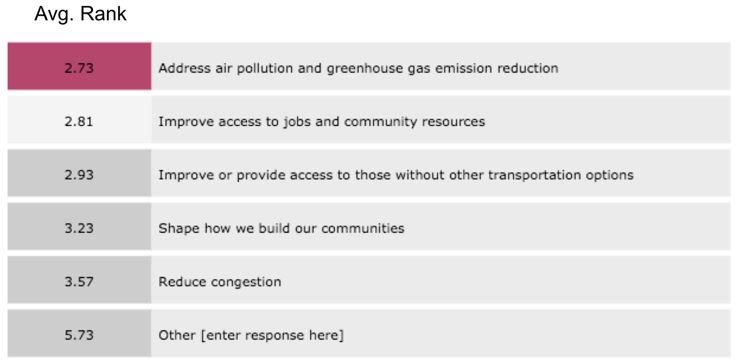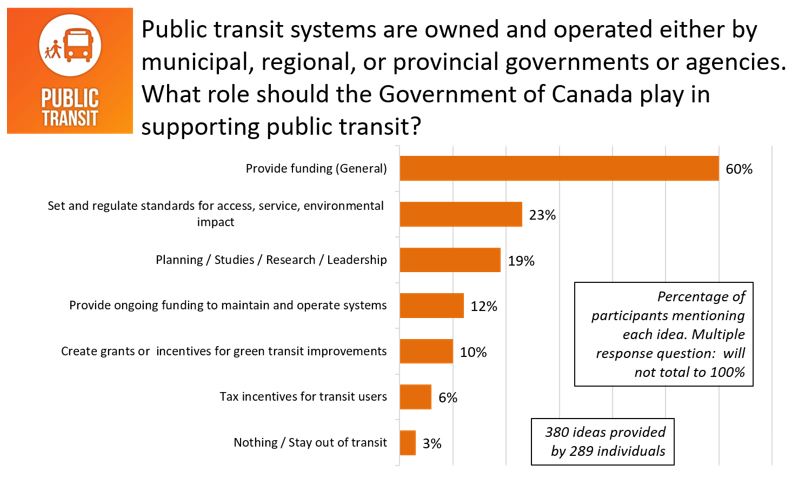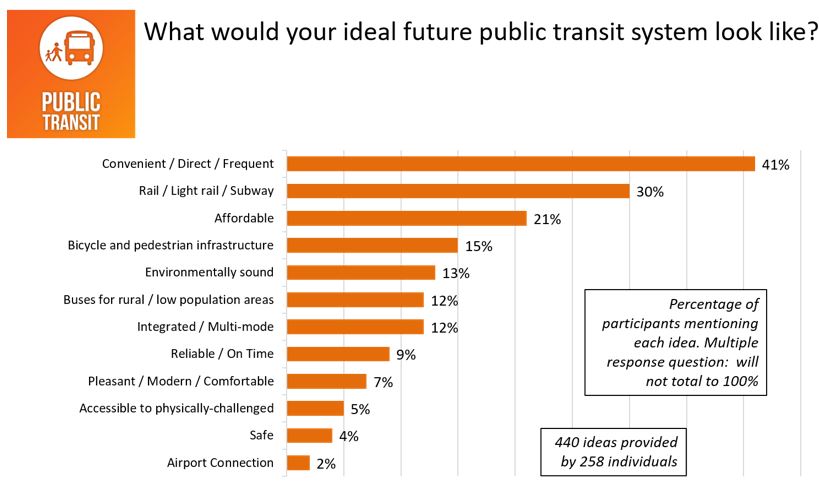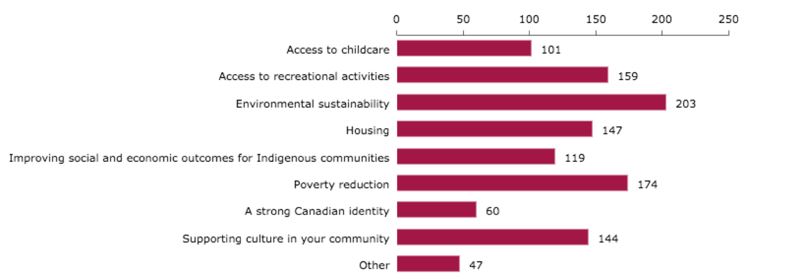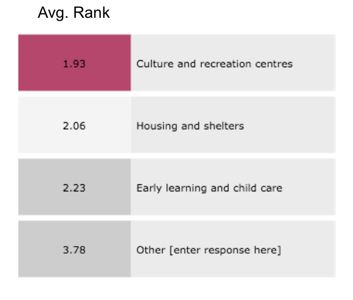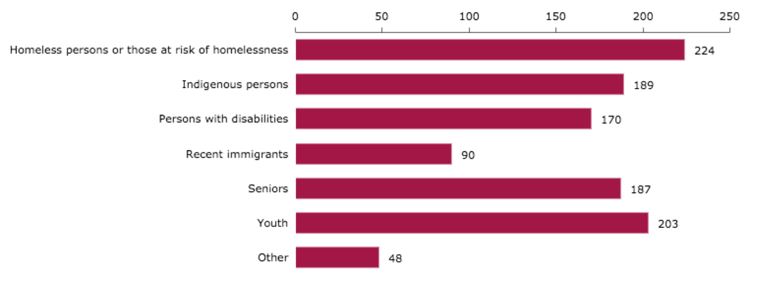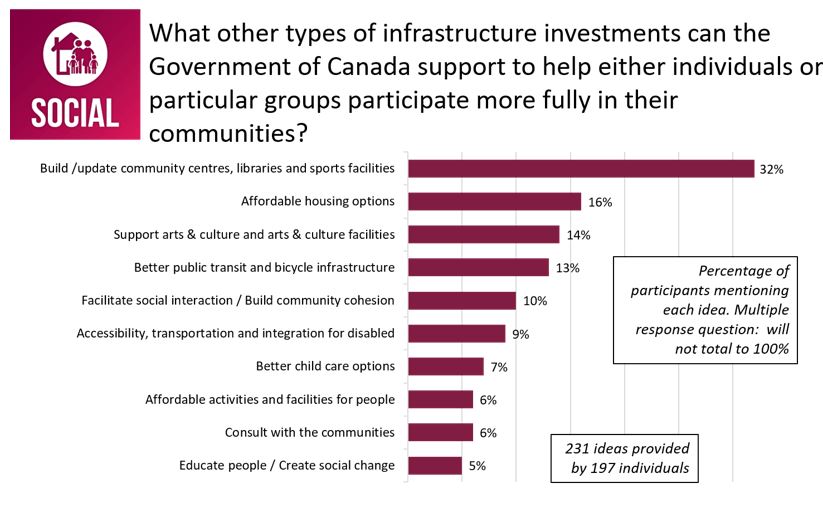Consulting with Canadians to Build the Investing in Canada Plan - Report
Executive Summary
The INFRAconsults engagement offered Canadians the opportunity to share their experiences and suggestions with regard to infrastructure investment. Canadians were invited to participate in an on-line forum, complete eWorkbooks, and provide written submissions.
Canadians who participated were generally positive about infrastructure investments and took the opportunity to provide their ideas, often including suggestions for specific projects or investments.
It is clear from the engagement that there are many areas where Canadians feel investment is needed, especially community facilities and public transit. They are also looking forward to moving away from fossil fuels and toward alternative energy to power their homes, vehicles and communities. Participants feel that investment decisions can help to create more cohesive and inclusive communities. Thus, they believe that infrastructure investments must consider not only the needs of today but also point the way for the future of Canadian communities and type of country we want to be.
The primary challenge Canadians identify to achieving the future communities they want is the cost. They say that "green" solutions are costlier to implement, especially in the short term and that the savings from green options take too long to accrue to offset the initial costs. Although cost is a primary barrier, respondents also identify a lack of expertise as a challenge, along with a lack of willingness among both elected representatives and the public.
Overall, Canadians' ideal vision of the future is a mix of transportation infrastructure, energy self-sufficiency, denser communities, and community and cultural facilities. Some also stress the importance of water infrastructure, more affordable housing, and more widespread Internet access.
Overview
The #INFRAconsults public engagement ran from July 20 to September 16, 2016 and was structured around four key themes. The following is a summary of the findings from the engagement. A full report follows.
Communities
Asked to rank the importance of five issues in their community, participants place highest importance on clean air and water. A second tier of priorities included poverty reduction, community services, and energy efficiency.
Participants place highest importance on social infrastructure. This is ranked as the type of infrastructure most in need of attention from a list of seven types tested. Public transit receives second highest ranking as an area in need of attention.
Participants often envision the future of their communities in terms of transit and transportation. Overall, participants' priorities in their vision for the future include a mix of transportation infrastructure, energy self-sufficiency, denser communities, and community and cultural facilities.
Green
Although social infrastructure is a strong component of the way Canadians think about progress, their vision of "green communities" is firmly grounded in conventional issues such as transit, renewable energy, waste management, and green space.
Participants proved to be open to most of the potential definitions of "green infrastructure" tested in the workbook, including environmentally-conscious buildings, natural infrastructure such as wetlands, and infrastructure focused on maintaining healthy and livable communities. Somewhat fewer think of "green" infrastructure to be structures which are resilient to climate change and natural disasters.
Thinking of environmental challenges in their community, participants focus on energy efficiency, climate change and clean waterways. In other words, their top two priorities relate to energy production and conservation rather than traditional environmental concerns such as pollution and access to natural spaces.
Participants suggest a high priority for the Government of Canada that matches their own concerns for their community noted earlier: clean water. There is also significant priority placed on reducing greenhouse gas emissions.
Cost is the primary barrier communities face in making "green" decisions about infrastructure. When asked to identify such challenges, cost is mentioned by participants three times more often than any other issue.
Participants believe the federal government's technology focus should be on alternative energy, especially wind and solar power. Almost one half of participants mention this technology as a priority. Better transit infrastructure, including electric cars and bicycles, is the second most commonly mentioned suggestion.
Public Transit
Environmental protection is the most common motivation among the one-half of participants who use public transit. Convenience and cost are also significant motivators.
Participants in communities not currently served by public transit rely primarily on private automobiles. Many of the remainder walk.
The most significant challenges to using public transit in general are convenience and speed. Many suggest that public transit does not travel frequently enough, does not serve the destinations they want, or takes too long to be practical. Reliability is also a problem according to a significant number of participants.
Participants widely believe that federal government should be contributing to the funding of public transit infrastructure across Canada. This includes general funding, operating grants, and tax incentives for construction or for users. However, there are also considerable numbers of participants who feel that the federal government has a role to play in setting standards for service, conducting research, and providing leadership.
Given the transit challenges noted earlier, it is not surprising that many eWorkbook participants identify their ideal transit system as frequent, convenient, and providing links directly to their destinations. However, there is also a significant attachment to the idea of using rail for transit specifically, whether subways, light rail or conventional rail. A number also stress the importance of affordability.
Social
Respondents do not focus on any single social goals which they feel should be the focus of infrastructure investments. Of the eight areas tested, the most commonly chosen were environment sustainability, poverty reduction, access to recreation facilities, and culture in the community. Access to childcare and better outcomes for indigenous communities are also chosen by significant minorities. The only area of notably lower importance was the creation and maintenance of a strong Canadian identity.
People completing the Social eWorkbook did not provide clear direction regarding which population groups should be the focus of social infrastructure spending.
If the objective is to facilitate participation in their communities, many participants say community centres, libraries and sports facilities are the best infrastructure investments. Other investments mentioned by a significant number of respondents include affordable housing, arts and culture, public transit, and childcare.
About This Report
This report summarizes and presents the results of the #INFRAconsults public engagement exercise undertaken by Infrastructure Canada in 2016. It seeks to capture and present the contributions and results from Canadians who participated, but does not seek to analyze these results in the context of Infrastructure Canada's mandate or current objectives.
Background
As part of Infrastructure Canada's engagement on the development of its long-term infrastructure plan, the Department sought to reach out to provincial, territorial and municipal partners, key stakeholders and the general public using a mix of traditional and digital engagement methods in order to engage as many stakeholders as possible.
Federal departments are responsible for identifying those interested in and affected by issues, and for providing them with open, meaningful, and reasonable opportunities for public participation at all stages of policy, program, and regulatory development and delivery. They should do so in a way that is open, transparent, and can reach as many Canadians as possible.
To this end, Infrastructure Canada sought stakeholder, INFC staff and public input on the development of a long-term infrastructure plan. The contributions collected through these activities will be used to inform policy, program, and regulatory development activities. Stakeholders were asked to provide input on four key issues: community infrastructure, green infrastructure, public transit infrastructure and social infrastructure.
This public engagement process was designed around an online collaboration platform, open to public participation from July 20, 2016 to September 16, 2016.
A communications plan was developed to support the engagement through various internal and external outreach activities. A fully integrated social media campaign was a key part of this communications plan. The various approaches all aimed to drive traffic to the engagement platform.
Figure 1: Seven Elements Used to Drive Traffic to the Infrastructure Canada Public Engagement Website
Engagement Design Process
In alignment with Canadian and international trends and emerging best practices, Infrastructure Canada took a progressive approach in engaging citizens in a series of opportunities to collaborate and to share their perspectives. This multi-pronged approach was designed to accommodate groups with varying levels of experience with and appetites for online modes of engagement.
Ultimately, the engagement was articulated around four distinct infrastructure themes:
- How infrastructure supports communities
- Green infrastructure
- Public Transit infrastructure
- Social infrastructure
And the platform provided four modes of participation:
- Completing an eWorkbook of questions.
- Collaborating with others to pitch and refine ideas in a Discussion Forum.
- Submission of a photo or video.
- Submission of a traditional written submission.
Participants were required to register to participate, and were asked to provide some basic demographic information including their postal code, although disclosure of this information was not required.
By the Numbers
1022 |
Registrants |
1473 |
eWorkbooks submitted (across the 4 themes) |
68 |
Ideas submitted |
16 |
Photo / Video submissions |
82 |
Written submissions |
Regional Representation
Registrants in the consultations represented all parts of Canada. The regional distribution of registrants reflected the national population in general, although certain regions (such as British Columbia, Alberta, and Saskatchewan) were present in somewhat larger numbers. Meanwhile Quebec and the Atlantic Region were represented in somewhat lower numbers than might be expected when compared to the provinces' proportional populations.
Figure 2: Participants by Region
The registrants included an even mix of male and females, generally quite reflective of the national population.
Female |
491 |
48.0% |
Male |
462 |
45.2% |
Other |
4 |
0.4% |
Did not disclose |
65 |
6.4% |
Overall, registrants tended to be younger than the national average with about one-half of participants less than 40 years old.
Participants by Age Range
Figure 3: Participants by Age Range
As shown below, female respondents were especially likely to be under 40. While women outnumbered men among registrants overall, registrants over 55 were predominantly male.
Participants by Gender and Age Range
Figure 4: Participants by Gender and Age Range
Urban vs Rural Representation
Postal codes were collected from participants, permitting analysis based on urban vs rural residence.
Approximately 80% of Canadians live in urban areas containing at least 1,000 people. The largest ten urban areas account for over one-half of the Canadian population. This is mirrored in the fact that approximately 85% of participants in the engagement reside in urban areas. Thus, the engagement results most strongly reflect the perspective of people living in urban communities, recognizing that the urban experience in Canada varies very significantly in terms of density and proximity to larger urban areas.
Gender |
Urban |
Rural |
Did not disclose |
Grand Total |
|---|---|---|---|---|
Female |
390 |
98 |
3 |
491 |
Male |
404 |
56 |
2 |
462 |
Did not disclose |
57 |
3 |
5 |
65 |
Other |
4 |
|
|
4 |
Grand Total |
855 |
157 |
10 |
1,022 |
Rural vs Urban Participants by Age Range
Figure 5: Rural vs. Urban Participants by Age Range
Traffic and Engagement
Web traffic on the platform was the key driver of contributions from participants. Participation followed typical patterns, as when user sessions are considered as a measure for web traffic, traffic drove registrations, and registrations drove overall participation. The correlation between traffic and eWorkbook completions becomes less direct as the engagement matures (as is to be expected). Notable is the sharp spike in written submissions near the close of engagement in response to communications efforts.
Figure 6: Web traffic and overall contributions
eWorkbooks for the four themes were completed at nearly equivalent rates and at an equivalent pace.
Figure 7: eWorkbook completions by theme
Social Media Impact and Support
The social media campaign was tracked directly by the Infrastructure Canada communications team who reported the following metrics:
- 1150 tweets were observed using the #INFRAconsults hashtag
- 1.4 M Twitter users reached
- INFC directly issued 168 tweets with the hashtag #INFRAconsults and #consultationsINFRA
- Of those 168, 158 tweets had click thru for a total of 14,325 click thru. Or, an average of 90.66 click-thrus per
- On average, approximately 150,000-200,000 Twitter users were reached every week
Google analytics offers a somewhat different perspective on traffic driven from social channels:
- According to Google Analytics, sessions referred via social channels over the course of the engagement from major social channels were as follows:
- Twitter: 1140 Sessions 50.11% of social sessions
- Facebook: 46.15% of social sessions
- LinkedIn: 81 Sessions 3.56% of social sessions
Infrastructure Canada Staff Participation
Only 11 registrants (approx. 1%) self-identified as being employees of Infrastructure Canada, many of whom were part of the project team, making the impact of their contributions and influence on the engagement negligible.
eWorkbook Findings By:
Communities
The Community theme in the engagement was an overarching discussion of all aspects of community living. Other themes discussed later were more specific to particular areas of potential infrastructure investment.
 |
Highlights:
|
Asked to rank the importance of five community outcomes, registrants placed highest importance on clean air and water. A second tier of priorities included poverty reduction and community services, and energy efficiency. In comparison, reduced traffic congestion and protection from climate change impacts were ranked of somewhat less importance. Thus, registrants are focusing on critical short-term issues rather than longer-term concerns and challenges.
When investing in infrastructure, what outcome is the most important to your community?
Figure 8: Average Rank for When investing in infrastructure, what outcome is the most important to your community?

423 Responses
* Note that a lower Average Rank score indicates a higher ranking.
The 102 written "other" responses tend to focus on social inclusion, social welfare, and recreation outcomes.
Reflecting findings discussed elsewhere in this report, registrants place high importance on social infrastructure. This is ranked as the type of infrastructure most in need of attention from a list of seven. Public transit receives second highest ranking as an area in need of attention. However, the differentiation in these rankings is not profound (ranging from 3.2 to 5.0 out of 7.0), suggesting that participants feel all these areas need attention with the possible exception of Internet Access.
What type of infrastructure is in the greatest need of attention in your community?
Figure 9: Average Rank for What type of infrastructure is in the greatest need of attention in your community?
407 Responses
* Note that a lower Average Rank score indicates a higher ranking.
Housing, cycling, walking and recreation infrastructure are themes which emerge from the 62 written "other" responses.
Responding in their eWorkbooks, participants often envision the future of their communities in terms of transit and transportation. More than half identify improvements in this area as a key feature of their community's future. Overall, the vision of the future is a mix of transportation infrastructure, energy self-sufficiency, denser communities, and community and cultural facilities. Also important to the future for some are improvements in water infrastructure, more affordable housing, and more widespread Internet access.
Once again it is important to note the wide range of visions which range from physical infrastructure to social development and cohesion. Canadians look to infrastructure spending to address a wide variety of needs, far beyond traditional infrastructure projects.
Figure 10: Responses for Change is constant and it affects the kind of infrastructure we have and the kind of infrastructure we need. When you think about your community and your country in the next 10, 20, or even 50 years, what does it look like? What kind of infrastructure does it have?
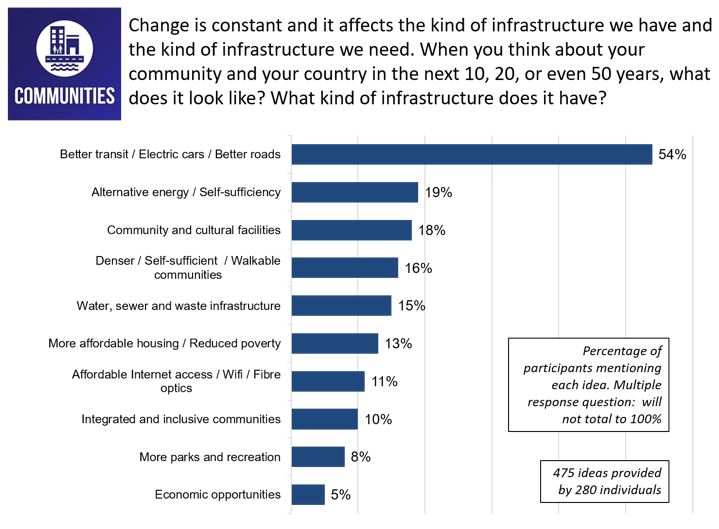
Discussion Forum
27 ideas were submitted publicly in the Communities area of the discussion forum. Approximately one-half of the ideas posted in this forum related to waste water treatment in Lloydminster. Other key themes included:
- The need for improvements in public transit
- The importance of cycling and walking infrastructure
- Provision of basic service and health care
- The potential for investments to build a sense of community
Green
 |
Highlights:
|
Although social infrastructure is a strong component of the way Canadians think about progress, their vision of "green communities" is firmly grounded in conventional issues such as transit, renewable energy, waste management, and green space. As the following figure shows, when participants think of "greening" their communities they are most focused on finding alternative energy sources and increasing the use of mass transit. There is, furthermore, a focus on community green spaces and nature conservation.
Within these ideas is also an underlying concept of redesigning the community itself to be more self-sufficient in food and energy, as well as more accessible for pedestrians and cyclists.
Figure 11: Responses for What makes (or would make) your community "green" or "greener"?
Participants proved to be open to most of the potential definitions of "green infrastructure" tested in the eWorkbook, including environmentally-conscious buildings, natural infrastructure such as wetlands, and infrastructure focused on maintaining healthy and livable communities. Somewhat fewer – roughly one half – think of "green" infrastructure to be structures which are resilient to climate change and natural disasters.
How do you define "green" infrastructure? Select all that apply
Figure 12: Responses for How do you define "green" infrastructure? Select all that apply
368 Responses
* Note that respondents were permitted to select multiple responses.
11 written "other" responses were received. No underlying theme was evident, suggesting the three options tested were generally considered complete.
Thinking of environmental challenges, participants focus on energy efficiency, climate change and clean waterways. In other words, their top two priorities relate to energy production and conservation rather than traditional environmental concerns such as pollution and access to natural spaces. While pollution and greenspace are nonetheless concerns, it is clear that energy production (and associated greenhouse gas emissions) is a top of mind environmental concern.
What is your community's biggest environmental challenge?
Figure 13: Responses for What is your community's biggest environmental challenge?
363 Responses
* Note that participants were permitted to select multiple responses.
Of the 28 written "other" responses, many focused on transit issues and automobiles.
Participants suggest a highest priority for the Government of Canada that matches their own concerns for their community noted earlier: clean water. There is also significant priority placed on reducing greenhouse gas emissions. While many value investments in technology and resiliency against climate change and natural disasters, these are accorded lower priority.
What should be most important to the Government of Canada when investing in "green" infrastructure?
Figure 14: Responses for What should be most important to the Government of Canada when investing in "green" infrastructure?
348 Responses
* Note that a lower Average Rank score indicates a higher ranking.
76 "other" responses were received to the above question. They noted the importance of clean air, transit, reducing fossil fuels, and nature conservation among many other issues.
There is little doubt that cost is the primary barrier communities face in making "green" decisions about infrastructure. This challenge is mentioned three times more often by participants than any other. Specifically, respondents say that "green" solutions are costlier to implement, especially in the short term and that the savings from green options take too long to accrue to offset the initial costs.
Although cost is a primary barrier, respondents also identify a lack of expertise as a challenge, along with a lack of willingness among both elected representatives and the public.
Figure 15: Responses for Are you or your community faced with challenges when making "green" decisions about infrastructure projects
Participants believe the federal government's technology focus should be on alternative energy, especially wind and solar power. Almost one half of participants mention this technology as a priority. Better transit infrastructure, including electric cars and bicycles, is the second most commonly mentioned suggestion. Participants also suggest tax policies and regulations to promote green technologies in general, increased efficiency and conservation in general, and environmental protection. Notably, there is a focus on environmental and community goals in these responses rather than simply green technologies.
Figure 16: Responses for What innovative technologies or solutions should the Government of Canada consider when thinking about "green" infrastructure
Although cost is the primary barrier noted above, most participants (85%) say they would still support a green infrastructure project which had higher upfront costs than a less green alternative.
If upfront construction costs for green infrastructure projects would be higher, would you support "greening" initiatives?
Figure 17: Responses for If upfront construction costs for green infrastructure projects would be higher, would you support "greening" initiatives?
339 Responses
Discussion Forum
12 ideas were submitted publicly in the green infrastructure area of the discussion forum. The contributions were diverse and included the following themes:
- Encouraging better transportation options locally and nationally
- Pursuing alternative energy sources which minimize emissions
- Working toward more self-sufficient communities with regard to energy and food
- Removing interprovincial obstacles to green infrastructure development.
- Reducing the North's reliance on diesel generators.
Public Transit
 |
Highlights:
|
A remarkable percentage of workbook respondents use public transit on a regular basis. This stands in significant contrast to Statistics Canada's 2011 National Household Survey which suggested approximately 12% of Canadian who commute to work use public transit. Thus, it appears that the Public Transit eWorkbook, unsurprisingly, attracted interest especially from public transit users.
Do you take public transit on a regular basis?
Figure 18: Responses for Do you take public transit on a regular basis?
397 Responses
Environmental protection is the most commonly-mentioned motivation for using public transit. Convenience and cost are also significant motivators. Interestingly, few feel that public transit is their fastest option.
If yes, why do you use public transit? Select all that apply:
Figure 19: Responses for If yes, why do you use public transit? Select all that apply
258 Responses
54 individuals provided written "other" responses. These were diverse but some noted the motivation to use transit created by high parking costs.
The most significant challenges to using public transit in general are convenience and speed. Many suggest that public transit does not travel frequently enough, does not serve the destinations they want, or takes too long to be practical. Reliability is also a problem according to a significant number of participants.
What is the biggest challenge to using transit in your community? Select all that apply:
Figure 20: Responses for What is the biggest challenge to using transit in your community? Select all that apply
382 Responses
18 written "other" responses were provided, but no commonality or theme was evident.
Participants in communities not currently served by public transit rely primarily on private automobiles. Many of the remainder walk.
If your community is not currently served by transit, which of the following statements most accurately describes your primary mode of transportation?
Figure 21: Responses for If your community is not currently served by transit, which of the following statements most accurately describes your primary mode of transportation?
216 Responses
Written "other" responses were few (12) and did not provide additional insight.
The alternative transportation method used by those without transit service does not vary significantly between medium-sized communities and small or rural communities. In both cases, private automobiles are the primary mode of transportation.
If your community is not currently served by transit, which of the following statements most accurately describes your primary mode of transportation? (Segmented)
Figure 22: Responses for If your community is not currently served by transit, which of the following statements most accurately describes your primary mode of transportation? (Segmented)
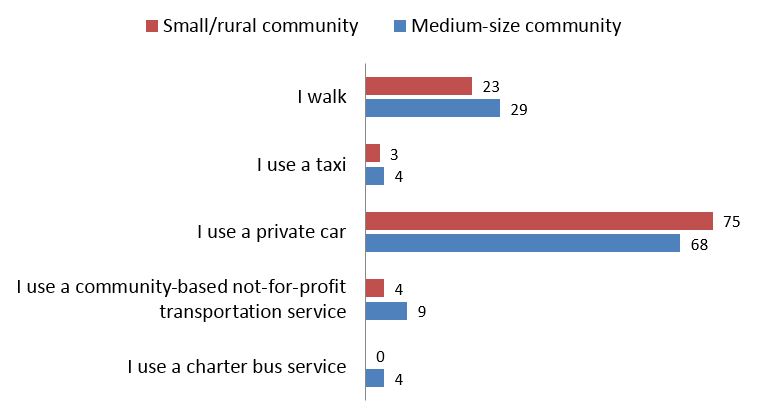
Small/rural community: 90 Responses
Medium-size community: 99 Responses
Asked to rank the importance of five objectives of spending on public transit, participants rank all five evenly. The average ranking ranges within a narrow window from 2.7 to 3.6 out of 5. Reducing air pollution and greenhouse emissions are highest priority overall, but many place importance on providing greater access, shaping communities and reducing congestion. All these objectives are important to participants.
Please rank with the most important at the top and least important at the bottom. Investing in public transit should help to:
Figure 23: Responses for Please rank with the most important at the top and least important at the bottom. Investing in public transit should help to:
369 Responses
* Note that a lower Average Rank score indicates a higher ranking.
"Other" responses (40) are diverse but some suggest improving community health and ensuring full accessibility for all members of society.
Participants widely believe that federal government should be contributing to the funding of public transit infrastructure across Canada. This includes general funding, operating grants, and tax incentives for construction or for users. However, there are also considerable numbers of participants who feel that the federal government has a role to play in setting standards for service, conducting research, and providing leadership.
Public transit systems are owned and operated either by municipal, regional, or provincial governments or agencies. What role should the Government of Canada play in supporting public transit?
Figure 24: Responses for Public transit systems are owned and operated either by municipal, regional, or provincial governments or agencies. What role should the Government of Canada play supporting public transit
Given the transit challenges noted earlier, it is not surprising that many workbook participants identify their ideal transit system as frequent, convenient, and providing links directly to their destinations. However, there is also a significant attachment to the idea of using rail for transit specifically, whether subways, light rail or conventional rail. A number also stress the importance of affordability.
A second tier of priorities include the need to integrate all transit modes efficiently, including foot traffic and bicycles, as well as environmental impacts. People in rural areas especially say they need connections to urban areas which they presume will be provided by bus in the near future.
What would your ideal future public transit system look like?
Figure 25: Responses for What would your ideal future public transit system look like
Discussion Forum
14 ideas were submitted publicly in the Public Transit infrastructure area of the Discussion forum. The key themes were:
- The need to for an integrated national transportation network
- High speed rail options
- The importance of providing transit links to rural communities and small towns
- A discussion of whether buses or light rail are the best option for public transit
Social
 |
Highlights:
|
eWorkbook respondents do not focus on any single social goals which they feel should be the focus of infrastructure investments. Of the eight areas tested, the most commonly chosen were environment sustainability, poverty reduction, access to recreation facilities, and culture in the community. Access to childcare and better outcomes for indigenous communities are also chosen by significant minorities. The only area of notably lower importance was the creation and maintenance of a strong Canadian identity.
Infrastructure investments can help address a number of broader social goals. Please select the top three goals that are most important to you:
Figure 26: Responses for Infrastructure investments can help address a number of broader social goals. Please select the top three goals that are most important to you:
408 Responses
No additional themes were identified by the 12 written "other" responses.
eWorkbook respondents do not provide clear direction in choosing between the three social infrastructure priorities tested. They assign similar priority to: culture and recreation; housing and shelters, and early earning and childcare. That said, culture and recreation centres do receive the highest priority overall.
Of the social infrastructure priorities that the Government of Canada has already identified, please rank the most important target areas
Figure 27: Responses for Of the social infrastructure priorities that the Government of Canada has already identified, please rank the most important target areas
396 Responses
"Other" responses are diverse, but there is some emphasis on social inclusion, accessibility, and transit.
People completing the Social Infrastructure eWorkbook do not provide clear direction regarding which population groups should be the focus of social infrastructure spending. While the homeless or potentially homeless are the highest priority, many also believe attention should be focused on youth, indigenous people, seniors and people with disabilities.
Infrastructure investments can be used to help specific groups. Where do you feel we should focus our investments? Please select your top three.
Figure 28: Responses for Infrastructure investments can be used to help specific groups. Where do you feel we should focus our investments? Please select your top three.
401 Responses
Overall, the 14 written "other" responses did not identify any specific group for targeting.
If the objective is to facilitate participation in their communities, many participants say there is no better type of infrastructure investment than community centres, libraries and sports facilities. These are seen as integral to community cohesion and integration, especially in smaller towns and more rural areas.
Other investments mentioned by a significant number of respondents include affordable housing, arts and culture, public transit, and childcare. Others stress the importance of creating social interaction in communities, ensuring access for people with disabilities, maintaining affordability for users, and creating social change through education. Some also note the importance of consulting with communities themselves on this question.
What other types of infrastructure investments can the Government of Canada support to help either individuals or particular groups participate more fully in their communities?
Figure 29: Responses for What other types of infrastructure investments can the Government of Canada support to help either individuals or particular groups participate more fully in their communities?
Discussion Forum
15 ideas were submitted publicly under Social Infrastructure in the discussion forum. The key themes were:
- Increasing recreation opportunities
- Facilitating arts and culture experiences
- Child care services and schools
- Fostering economic innovation
Writter Submission
Eighty-two (82) substantive submissions were received from contributors. These were diverse in both depth and subject matter. Multi-page submissions from non-governmental organizations and municipal governments were common, as were short submissions from individuals concerned about a particular issue.
Without exception, the submissions were either neutral or supportive of the Government of Canada's infrastructure spending plan. The submissions fall into four general groups:
Municipal submissions (10).
These are generally specific listings of infrastructure projects within the municipality which should be considered for funding. These submissions also sometimes make recommendations regarding the funding process.
Labour and business submissions (7).
These submissions typically stress the importance of certain technologies or approaches to infrastructure spending or offer specific projects which they believe are worthy of funding.
Non-governmental groups (37).
These submissions vary widely but typically identify overall principles which should be kept in mind in infrastructure funding. Many focus on the social and economic value of recreation, arts and culture funding. A significant number propose criteria to be used in awarding infrastructure funding. Some argue for specific technologies, such as geothermal or electric vehicles.
Individual submissions (27).
27 Individual Canadians took the time to share their thoughts on infrastructure spending. Their comments are widely diverse and range from local infrastructure issues to overarching principles.
The submissions are summarized below. Submission numbers are preserved for cross-referencing. Note that submission numbers are not continuous.
Municipal Submissions
- Township of HornePayne, Ontario
- Provides a list of local infrastructure projects which would benefit from funding.
- Town of Porcupine Plain, Saskatchewan
- Identifies local infrastructure needs and suggests that an allocation system (submission # rather than application-based system) would be more likely to be beneficial to small and rural municipalities.
- Sturgeon County, Alberta
- Identifies local infrastructure needs – including transit, green infrastructure and social infrastructure.
- City of Nelson, British Columbia
- Proposes procedural options for the allocation of infrastructure funding, specifically a change from a traditional approach involving an annual call for applications.
- Saskatchewan Association of Rural Municipalities
- Argues for ensuring that rural municipalities receive additional infrastructure funding.
- Saskatchewan Urban Municipalities Association
- Identifies infrastructure challenges and opportunities in Saskatchewan municipalities.
- Region of Peel, Ontario
- Provides information regarding infrastructure needs in the Region of Peel.
- County of Renfrew, Ontario
- Discusses infrastructure needs of rural municipalities and argues for a formula based approach to infrastructure spending rather than an approach based on applications. Also provides recommendations to maximize the effectiveness of infrastructure spending.
- York Region, Ontario
- Provides a list of three green infrastructure projects in the region requiring funding.
- Regional Municipality of Halton, Ontario
- Identifies opportunities for infrastructure spending Halton.
Business and Labour Groups
- International Union of Painters and Allied Trades (IUPAT - 100,000 members)
- Emphasizes the role corrosion plays in undermining infrastructure and argues for careful consideration of corrosion control in infrastructure management, including protective coatings. IUPAT has developed certification for professional coating appliers. Also seeks support for apprenticeship programs.
- Canadian Geothermal Energy Association (multiple written submissions)
- Argues for the consideration of geothermal energy technology as a viable alternative to fossil fuels which uses existing expertise developed in the drilling and mining industries.
- Provides technical insight into the feasibility of geothermal energy in Canada, including the North, by Waterloo Institute for Sustainable Energy
- Provides specific funding proposals.
- Provides definitions.
- Bayside Group
- A specific proposal for an Energy Institute to be located in Summerside, Prince Edward Island.
- Canadian Chamber of Commerce
- Provides recommendations regarding trade-enabling infrastructure, public transit, and unlocking private sector infrastructure investment.
- Canadian Union of Public Employees
- Supports spending in each of the four areas identified and makes some recommendations regarding each.
- Cement Association of Canada
- Identifies environmental benefits of concrete and urges the increased use of innovative concrete technologies now available.
- St. Catharines Hydro Generation Inc.
- Outlines proposed power generation plant in St. Catharines.
Non-governmental organizations
- Canadian Parks and Recreation Association (CPRA) / Canadian Recreation Facilities Council (CRFC)
- "Sport and recreation infrastructure is one of the most important core investments that can be made into the prosperity, health and security of urban and rural communities. [But] history clearly demonstrates that many municipalities will allocate funds to transit or sewer projects rather than pools, arenas or trails".
- Recommendation 1: Create a national inventory of recreational facilities.
- Recommendation 2: Identify need for repairs and upgrades and create a dedicated fund.
- Recommendation 3: Create a dedicated fund for new recreation infrastructure with a special focus on ethnically diverse urban areas.
- Recommendation 4: Provide $1.2 billion per year split between the two funds.
- Consortium of 14 Organizations
- Analytica Advisors, ALUS Canada, ArcTern Ventures, The Cement Association of Canada, City of Vancouver, Clean Energy Canada, Ecology Action Centre, EllisDon Corporation, Environmental Defence, Evergreen, Insurance Bureau of Canada, Intact Centre on Climate Adaptation, University, of Waterloo, MaRS Cleantech Venture Services, NRStor.
- Proposes and explains three criteria for infrastructure spending: Full Economic Lifecycle Cost Assessment, Full Carbon Cost Assessment, And "Best Available Solutions" Assessment.
- The Canadian Artists Representation/ le Front des artistes canadiens (CARFAC)
- Suggests that public art should be eligible for inclusion under infrastructure spending.
- Canadian Arts Coalition
- Affirms the importance and benefits of dedicating a portion of infrastructure spending to arts facilities.
- An Alberta Electric Vehicle Consortium
- Submitted by: Alberta Electric Vehicle Owners, Electric Vehicle Association of Alberta, Alberta Tesla Owners Club of Alberta, and Nissan Leaf Owners Group.
- Discusses potential benefits and approach to increasing adoption of electric vehicles.
- ArtsBuild Ontario
- Argues for extending and increasing funding eligibility and actual spending on "Cultural Spaces".
- Green Infrastructure Ontario (GIO) Coalition
- Recommendation1: Implement a 'consider living green infrastructure first' policy for infrastructure funding.
- Recommendation 2: Allocate 15% of infrastructure funds to a dedicated funding stream for living green infrastructure.
- Recommendation 3: Work with partners to develop and implement a national living green infrastructure strategy.
- Digby and Area Affordable and Supportive Housing (DAASH) Group
- Discusses situation in Digby and area, Nova Scotia, as well as suggesting that infrastructure funds must be shared with rural communities.
- Community Housing Options Initiative through Collaboration and Engagement (CHOICE) Coalition
- Discusses situation in Yarmouth County, Nova Scotia, as well as suggesting that infrastructure funds must be shared with rural communities.
- Engineers Canada
- Offers five detailed recommendations for the use of infrastructure funding, including standards, emergency preparedness, and First Nations.
- Conservation Ontario
- Calls for "Continued and enhanced investment in conservation authority flood management operations in order to develop stronger resiliency to the increasing impacts of climate change on our natural resource systems".
- Council of Canadians with Disabilities
- Hosted a national web-based consultation, stressing in all responses the importance of increasing accessibility for Canadians with disabilities.
- Nature Conservancy Canada
- Argues for priority attention to natural infrastructure and concludes "Long-term, comprehensive funding from Infrastructure Canada is needed to support innovative natural infrastructure initiatives to conserve our lands and waters, and as a means of contributing to sustainable and smart growth".
- Fédération des communautés francophones et acadienne
- Notes that infrastructure spending on community facilities and resources are essential to the maintenance and promotion of the French- language in Canada.
- Fédération culturelle canadienne-française
- Stresses the importance of French language spaces for the protection and promotion of the language in Canada, and the value of cultural facilities in this regard. Suggests these be included as eligible spending for infrastructure grants.
- Clean Energy Canada
- Recommends that Canada's climate commitments should be reflected in all of the federal government's infrastructure decisions.
- Proposes and explains three criteria for infrastructure spending: Full Economic Lifecycle Cost Assessment, Full Carbon Cost Assessment, And "Best Available Solutions" Assessment.
- Canadian Council for Public-Private Partnerships
- Discusses the value of public-private partnerships in developing infrastructure and provides specific recommendations regarding First Nations and Northern issues related to infrastructure.
- Tennis Canada
- Notes the contributions made by National Sports Organizations and the value provided by investments in sports infrastructure.
- Sustainable Dialogues Canada
- Identifies guiding principles which should be used in the allocation of infrastructure spending as well as specific spending recommendations.
- Provides notes from a group discussion: "Working session: Infrastructure Investment Priorities" including a summary of key messages.
- Canadian Arts Presenting Association
- Writes in support of submissions by Canadian Arts Coalition and of ArtsBuild Ontario.
- Option transport durable
- A proposal regarding the power grid in Montreal.
- The Canadian Dance Assembly
- Calls for cultural and recreation spending to be eligible for infrastructure spending.
- Curling Canada
- Explains the social and economic benefits derived from the sport of curling and recommends that infrastructure spending should include upgrades and energy efficiency for sports facilities.
- Ducks Unlimited Canada
- Notes the importance of natural infrastructure and makes specific recommendations about how infrastructure spending should be awarded and managed.
- Canadian Council on Renewable Electricity
- Identifies four types of projects which should receive priority infrastructure funding.
- National Association of City Transportation Officials (US)
- Notes that data shows that increased bike use actually reduces accidents. Argues that better bike infrastructure is an important driver for economic and environmental progress. Suggests helmet laws act to reduce and discourage bike use, including bike share programs.
- National Trust for Canada
- Recommendation 1: Create a go to source of federal infrastructure funds for grassroots groups and charities with worthy heritage projects.
- Recommendation 2: A "Heritage Lens" and "Do No Harm" policy for infrastructure spending.
- Canadian Public Works Association (CPWA - 29,000 members)
- Recommendation 1: Provide additional, long-term and predictable funding for building asset management capacity in municipalities across Canada.
- Recommendation 2: Invest additional funds in climate change mitigation and in building climate resilient infrastructure in a consistent, long-term and predictable manner.
- Recommendation 3: Consider supporting the use of a sustainability rating tool such as Envision® which provides municipalities with a holistic framework for evaluating and rating the community, environmental and economic benefits of all types and sizes of infrastructure projects.
- Saskatchewan Snowmobile Association
- Highlights the economic and social importance of snowmobiling.
- Calls for infrastructure spending on upgrading and maintaining snowmobiling trails.
- Saskatchewan Parks and Recreation Association
- Details the economic social importance of parks and recreation. Proposes that a fund be developed for these aspects of infrastructure as well as promoting recreation.
- Identifies the need for a national registry of parks and recreation facilities.
- Vivre en Ville
- Focus importance on green infrastructure projects, affordable housing, and public transit. Suggests the need to focus on assuring that funding is efficient and well-planned.
- Moelle épinière et motricité Québec
- Calls for investment and regulation to ensure access to public transit among people with physical challenges.
- Argues for increased parking spaces dedicated to people with physical challenges as well as a harmonization of regulations regarding this issue.
- Suggests a census of available housing for people with physical challenges, a centralization of information about this housing, a mandate to ensure people with disabilities receive an appropriate share of social housing, and investment in the sector through grants and tax incentives.
- Details the need for government buildings and services to be accessible to people with physical challenges.
- Alberta Parks and Recreation Association
- Recommendation 1: Create a national inventory of recreational facilities
- Recommendation 2: Identify need for repairs and upgrades and create a dedicated fund.
- Recommendation 3: Create a dedicated fund for new recreation infrastructure with a special focus on ethnically diverse urban areas.
- Recommendation 4: Provide $1.2 billion per year split between the two funds.
- Community Association, Yukon
- Writes in support of the CPRA/CRFC submission.
- Calls for operational funding of community centres in small communities.
- Y Canada
- Affirms the importance of social infrastructure.
- Recommends:
- Setting aside a specific allocation of resources for each social infrastructure category in fiscal year 2017/18 and in the long-term infrastructure plan.
- Ensuring that charities and not-for-profit organizations are eligible for federal infrastructure programs.
- Engaging with charities and not-for-profit organizations as stakeholders during the design of the new long-term infrastructure plan.
- Buy Social Canada
- Recommends: utilize a cross ministerial collaboration approach to infrastructure goals.
- Recommends: apply social procurement policy to infrastructure contracts.
- Recommends: achieve social innovation through infrastructure purchasing demand.
- Recommends: establish a cross-sectoral roundtable implementation design and monitor process.
- Recommends: partner with Buy Social Canada, a social procurement intermediary service.
- Canadian Urban Transit Association
- Provides specific recommendations about how infrastructure funding for public transit should be allocated and how projects should be evaluated.
- Ottawa Renewable Energy Coop
- Recommends that municipal energy projects be eligible for infrastructure funds, that community ownership be prioritized over private enterprise, and that money should be invested in municipal capacity to develop community energy projects.
Submissions from Individuals
- Argues for a gradual growth of electric rail transportation in Manitoba, starting in large urban areas and moving outward over time.
- Asks for a bypass to route the Trans-Canada Highway around Duncan /North Cowichan for reasons of safety, congestion, and environmental factors.
- Identifies need for funding to dredge Yarmouth harbour and raise the harbour wall in preparation for rising sea levels. Also proposes funding to enlarge the marina and construct a cruise ship port in the town.
- Suggests the construction of a splash pad in Dundonald Park in Centretown, Ottawa and longer hours for City-run splash pads in general.
- Recommends:
- Allowing seniors to ride school buses used by children in rural areas, paying a fare.
- Widening the shoulders of rural highways for safer walking and cycling.
- Constructing electric rail transit along highways or disused rail beds. (Submission #44)
- Suggests solutions for the "critical shortage of skilled personnel to develop, design, finance, build, operate and maintain renewable and clean energy projects".
- Argues that the use of automobiles and especially trucks should be reduced, in part because of the damage to road infrastructure caused by truck transportation.
- Says that Canada should "offer sustainable, reliable, and adequate funding for municipalities to provide the services we need." Also suggests that private public partnerships are a mistake.
- Believes that federal infrastructure spending should be used to implement a 'Green New Deal' which invests heavily in green projects.
- Identifies issues with elevator maintenance and proposes that elevator shafts be treated as transportation corridors for the purposes of regulation in order to ensure safety and convenience.
- Stresses the potential benefits of making all stations in Ottawa's LRT system easily accessible by bicycle.
- Points out the relevance and social importance of libraries and calls for spending on upgrading and modernizing libraries in Canada, including better Internet access.
- Proposes that a portion of HST/GST should be assigned to municipalities for infrastructure.
- Suggests that natural systems be included as eligible for infrastructure grants related to environmental protection.
- Calls for regional water pipelines to serve rural residents currently using independent water sources.
- Notes the potential for geothermal to provide energy in Canada's North.
- Proposes a pilot project to convert disused oil wells in Alberta to geothermal power generation (includes attachment of pilot project from C-FAR Technologies).
- Urges the federal government to "consider living green infrastructure first".
- Writes in support of the recommendations made in the submission by Canadian Parks and Recreation Association (CPRA) / Canadian Recreation Facilities Council (CRFC).
- Lists eight areas which should be the focus of federal infrastructure spending: federal buildings, education buildings, passenger rail, bike infrastructure, streetlights, landfill mitigation, clean water and climate change mitigation.
- Identifies potential role of First Nations in sustainable energy development.
- Calls for federal assistance in providing seniors' housing in Nova Scotia
- Proposes that all infrastructure spending should consider Universal Design – accessibility for all parts of the community.
- Recommends that recreation facilities receive significant infrastructure funding.
- A proposal for a national bedbug strategy.
- Argues for allocation funding rather than application-based. Also suggests that timelines are too short and that funding decisions tend to punish municipalities who have been careful to reserve funds for infrastructure themselves.
- Says that stricter standards for green technology funding are required, as many solutions which are funded are not optimal.
- Date modified:
